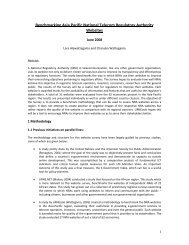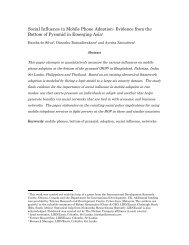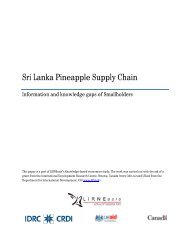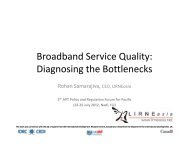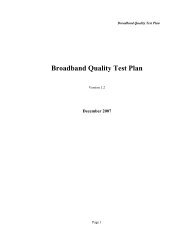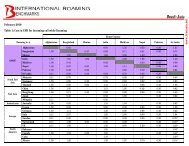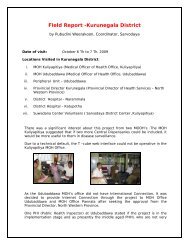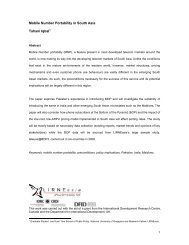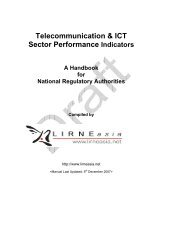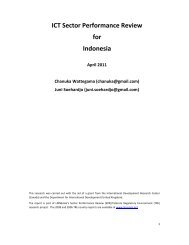Agricultural Value Added Services (VAS) through ... - LIRNEasia
Agricultural Value Added Services (VAS) through ... - LIRNEasia
Agricultural Value Added Services (VAS) through ... - LIRNEasia
You also want an ePaper? Increase the reach of your titles
YUMPU automatically turns print PDFs into web optimized ePapers that Google loves.
<strong>Agricultural</strong> <strong>Value</strong> <strong>Added</strong> <strong>Services</strong> (<strong>VAS</strong>) <strong>through</strong> Mobile 2.0<br />
KEY RECOMMENDATIONS<br />
POLICY BRIEF<br />
Partnerships Matter<br />
Telecommunication companies are best<br />
to leave content provision to the<br />
specialists. When content comes from<br />
specialized information providers,<br />
customers value the information more.<br />
Such providers are best in generating<br />
customizable, relevant and timely<br />
information. This can be a win-win<br />
solution for both.<br />
Build, Advertise and They Will Come<br />
Mobile based agricultural information<br />
services, need greater visibility. Proactive<br />
awareness building by companies will<br />
help popularize the service.<br />
Telecommunication operators need to<br />
view such services as potential revenue<br />
generators by themselves rather than as<br />
teasers to increase their subscriber<br />
market share.<br />
Voice is Still King<br />
With lower literacy levels, small farmers<br />
prefer voice based solutions more than<br />
text based solutions. If it is text based,<br />
then use of local languages remains key.<br />
Text also allows for advice to be stored<br />
and used later. Irrespective greater<br />
access requires more awareness.<br />
INTRODUCTION<br />
While it has been declining in recent years, agriculture’s<br />
share of a country GDP continues to be high in South Asia<br />
(15.8% in India, 12.8% in Sri Lanka, 20.8% in Pakistan).<br />
With large segments of the South Asian population still<br />
dependent on agriculture for their livelihoods (the sector<br />
directly employs 17.5% in India, 43% in Pakistan and 32.7%<br />
in Sri Lanka), allowing them to engage more effectively in<br />
agricultural markets remains paramount. Effective<br />
engagement in agricultural markets translates into farmers<br />
having the means to utilize market price information in<br />
their livelihood decisions and being able to leverage their<br />
physical commodities to improve and smoothen their<br />
incomes. The latter would mean farmers having the ability<br />
to engage in financial instruments such as forward<br />
contracts. Furthermore, they would be able access to crop<br />
insurance and loans using either their forward contracts or<br />
their harvested commodities as collateral (e.g. commodity<br />
backed financing using warehouse receipts).<br />
The first step in this process is having accurate and timely<br />
market price information. This decreases information<br />
asymmetry and allows farmers to increase their bargaining<br />
power in market transactions. ICTs are particularly suited<br />
to addressing this need and it has been generally<br />
recognized by developmental organizations as well as<br />
private sector players. This is evident by the multitude of<br />
projects in South Asia that are ongoing (eChaupal, RML,<br />
and others in India, GGS in Sri Lanka).<br />
AGRICULTURAL <strong>VAS</strong><br />
With the number of urban subscribers peaking,<br />
telecommunication companies are looking toward the<br />
rural front for the next wave of subscribers. Furthermore,<br />
with the budget telecom network business model<br />
squeezing their profit margins, <strong>Value</strong> <strong>Added</strong> <strong>Services</strong> (<strong>VAS</strong>)<br />
represent further revenue streams in a market where<br />
voice is commoditized.<br />
Since 2008, multiple operators in India have started<br />
agricultural information services targeting rural<br />
subscribers. Most of the agricultural <strong>VAS</strong> includes a mix of<br />
crop advisory information, weather updates and market<br />
price information.<br />
Business Models<br />
A variety of business models are being employed, mostly<br />
as partnerships between telecommunication companies<br />
and other organizations. With some farmer organizations,<br />
especially fertilizer cooperatives having millions of<br />
members, telecommunication companies are seeing them<br />
as a viable partner in order to increase their subscriber<br />
numbers. For example, IFFCO Kisan Sanchar Ltd. (IKSL), a<br />
joint venture between Bharti Airtel and IFFCO (a fertilizer
cooperative with over 55 million farmers) even issue<br />
specialized branded SIMS for IFFCO members (Airtel has<br />
over 1.5 million subscribers of this specialized IKSL<br />
package), which includes free agricultural <strong>VAS</strong>. However,<br />
operators are even getting into joint ventures with<br />
specialized <strong>VAS</strong> companies as seen by Mandi on Mobile<br />
(BSNL & OnMobile) and Mandi Bhav (Tata Teleservices and<br />
Impetus Technologies). Only one example exists of a <strong>VAS</strong><br />
company going at it alone which is service provided by<br />
Reuters Market Light (RML). RML has chosen to specialize<br />
in information collection and sending customized content<br />
for each of its subscribers; but, in some regions, even they<br />
have partnered with an operator (Idea Cellular’s Idea<br />
Krishi subscription plan).<br />
Most operators are using agricultural <strong>VAS</strong> as a teaser to<br />
increase their rural subscriber base and reduce churn.<br />
They have for the most part treated the potential of the<br />
<strong>VAS</strong> itself to generate additional revenues as a second<br />
priority. Hence, some of the services are being offered for<br />
free by operators. When it is a paid service, it is generally<br />
via a time-based subscription model (one month, 3 month,<br />
6 month or annual subscriptions). Pricing varies from<br />
service to service, but generally ranges from INR 15-100<br />
per month. Usage based pricing is also available on some<br />
services (e.g. Mandi on Mobile), but is less common.<br />
Technology<br />
<strong>Agricultural</strong> <strong>VAS</strong> are being delivered using a variety of<br />
technologies. The most common technology choice is SMS<br />
and IVR, but they are also available (depending on the<br />
specific service) via WAP, USSD and even as mobile<br />
applications. When delivery is text based most services are<br />
available in up to 9 local languages. Given lower literacy<br />
levels amongst farmers, it is not surprising that voice<br />
based solutions are preferred over text. Furthermore, local<br />
language support is not always available and the default<br />
delivery language is mostly Hindi.<br />
Customized, relevant and timely content<br />
Farmers see value in such services only when the<br />
information provided by these services is timely and<br />
relevant to their own specific produce. Generic crop advice<br />
is not valued high. Even with respect to market prices,<br />
they require accurate prices from the markets of their<br />
choice; which varies from farmer to farmer. Customized<br />
content therefore, is more the forte of specialized <strong>VAS</strong><br />
companies like RML. Their market price information for<br />
example (which they collect themselves), are viewed to be<br />
more accurate and their customized crop advise and<br />
weather updates were found to be valued more than the<br />
generic information available via services such as those<br />
offered by IKSL.<br />
THE WAY FORWARD<br />
It is clear that voice based solutions such as IVR are more<br />
suitable for small farmers with low literacy levels.<br />
However, voice based solutions are costlier to implement.<br />
Even when text is used as the delivery mechanism, the use<br />
of local language fonts remains key. The current 9 local<br />
languages supported by the services are not enough, but<br />
incorporating additional local languages may require<br />
special Unicode supported phones which may be costlier.<br />
Telecom operators on their side need to prioritize such<br />
services as potential revenue sources. There is<br />
demonstrated demand for such services and it remains in<br />
the interest of the operators to raise awareness about<br />
such services and advertise them prominently.<br />
While operators have a competitive advantage in<br />
distribution and sales, content remains their weakness.<br />
Hence, operators need partnerships with specialized<br />
information providers with a keen sense of the farmers’<br />
information needs. The nature of this relationship needs<br />
to be mutually beneficially and while this area is still new<br />
there are numerous business models that can be tried and<br />
tested. Apple’s App Store model for example, has been<br />
extremely popular and mutually beneficial to both<br />
developer as well as Apple. A similar approach could work<br />
here.<br />
From the point of view of small farmers, such agricultural<br />
information services are just the first step towards more<br />
effective market engagement. What is further needed are<br />
access to finance, insurance and storage. ICTs and mobiles<br />
in particular can play an important role in connecting<br />
relevant stakeholders. mMoney services have the<br />
potential to bring micro-finance facilities to such small<br />
farmers. Even mobile based micro-insurance schemes for<br />
small farmers are currently available in places like Kenya<br />
(Kilimo Salama). Innovative services coupled with<br />
innovative business models can go a long way towards<br />
making agricultural markets in developing countries more<br />
efficient and thus help move millions of small famers out<br />
of perpetual poverty.<br />
Sriganesh Lokanathan<br />
+94 77 762 6902 | sriganesh@lirneasia.net<br />
Rohan Samarajiva, PhD<br />
+94 77 735 2361 | rohan@lirneasia.net




